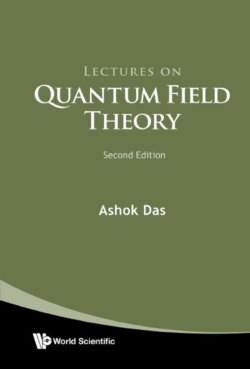Читать книгу Lectures on Quantum Field Theory - Ashok Das - Страница 6
На сайте Литреса книга снята с продажи.
ОглавлениеPreface
Preface to the First Edition
Over the past several years I have taught a two-semester graduate course on quantum field theory at the University of Rochester. In this course the ideas of quantum field theory are developed in a traditional manner through canonical quantization. This book consists of my lectures in this course. At Rochester, we also teach a separate course on quantum field theory based on the path integral approach and my lectures in that course have already been published by World Scientific in
A. Das, Field Theory: A Path Integral Approach (Second Edition), World Scientific, Singapore (2006).
The material in the present book should be thought of as complementary to this earlier book. In fact, in the present lectures, there is no attempt to develop the path integral methods, rather we use the results from path integrals with a brief discussion when needed.
The topics covered in the present book contain exactly the material discussed in the two-semester course except for Chapter 10 (Dirac quantization) and Chapter 11 (Discrete symmetries) which have been added for completeness and are normally discussed in another course. Quantum field theory is a vast subject and only selected topics, which I personally feel every graduate student in the subject should know, have been covered in these lectures. Needless to say, there are many other important topics which have not been discussed because of time constraints in the course (and space constraints in the book). However, all the material covered in this book has been presented in an informal (classroom like) setting with detailed derivations which should be helpful to students.
A book of this size is bound to have many possible sources of error. However, since my lectures have already been used by various people in different universities, I have been fortunate to have their feedback which I have incorporated into the book. In addition, several other people have read all the chapters carefully and I thank them all for their comments. In particular, it is a pleasure for me to thank Ms. Judy Mack and Professor Susumu Okubo for their tireless effort in going through the entire material. I am personally grateful to Dr. John Boersma for painstakingly and meticulously checking all the mathematical derivations. Of course, any remaining errors and typos are my own.
Like the subject itself, the list of references to topics in quantum field theory is enormous and it is simply impossible to do justice to everyone who has contributed to the growth of the subject. I have in no way attempted to give an exhaustive list of references to the subject. Instead I have listed only a few suggestive references at the end of each chapter in the hope that the readers can get to the other references from these sources.
The Feynman graphs in this book were drawn using Jaxodraw while most other figures were generated using PSTricks. I am grateful to the people who developed these extremely useful softwares. Finally, I would like to thank Dave Munson for helping out with various computer related problems.
Ashok Das,
Rochester
